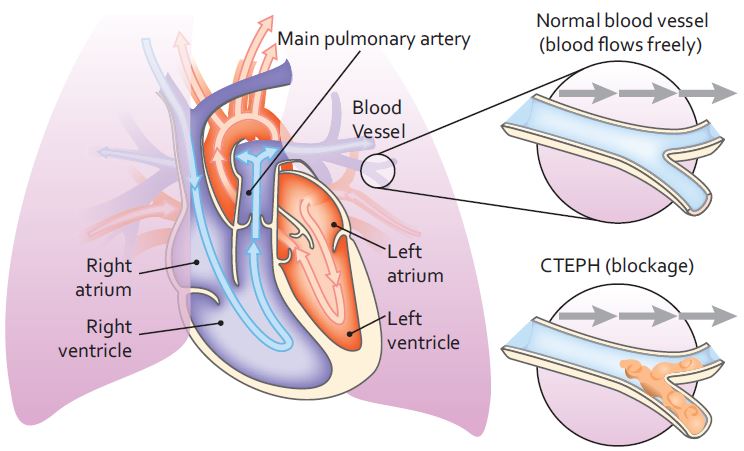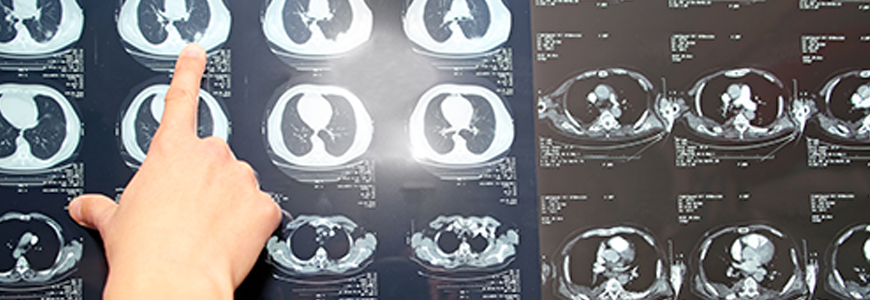Chronic thromboembolic pulmonary hypertension (CTEPH) is a condition where there is elevated blood pressure in the pulmonary arteries caused by chronic blood clots (thromboembolic), which obstruct the free flow of blood through the lungs.

About CTEPH
To better understand CTEPH, you first need to understand the name:
- Chronic means a condition that lasts a long time, like months or years.
- Thromboembolic means that a blood clot, or thrombus, forms in a blood vessel in the body and travels through your arms, legs, or a vein into blood vessels in the lungs, where it clogs the arteries. A blood clot in the lungs is called a pulmonary embolism (PE).
- Pulmonary is a medical term that refers to the lungs.
- Hypertension means high blood pressure—in this case, it refers to high blood pressure in your lungs
After your blood has delivered oxygen to the tissues of your body, the blood needs to come back to the lungs to get more oxygen. The blood is returned to the right side of the heart, which in turn pumps the blood into your lungs. When the blood vessels in the lung have been blocked by a clot for a long time, it raises the blood pressure. This is called pulmonary hypertension.
In CTEPH, the pulmonary clots do not go away. The clot extends into the artery, stick to the walls and develop into scar tissue. The blockage increases pulmonary pressure, can cause narrowing of the blood vessels throughout the lung and reduce blood flow into the lungs.
Symptoms
The signs and symptoms of pulmonary hypertension develop slowly. You may not notice them for months or even years. Symptoms get worse as the disease progresses.
Pulmonary hypertension signs and symptoms include:
- Blue lips and skin (cyanosis)
- Chest pressure or pain
- Dizziness or fainting spells (syncope)
- Fast pulse or pounding heartbeat (palpitations)
- Fatigue
- Shortness of breath (dyspnea), initially while exercising and eventually while at rest
- Swelling (edema) in the ankles, legs and eventually the belly area (abdomen)
Treatment
CTEPH is potentially curable by a surgical procedure called pulmonary thromboendarterectomy (thrombow-end-arter-ectomee) (PTE, sometimes referred to as pulmonary endarterectomy, or PEA). It is currently the “gold standard” treatment for patients with CTEPH who are surgical candidates. Deciding on whether a patient is a surgical candidate is performed by a multidisciplinary team at Duke, which includes experts from surgery, pulmonary, cardiology and radiology.
Patients who aren’t medically eligible for PTE may benefit from balloon pulmonary angioplasty (BPA). BPA is an innovative therapy where small balloons are used to open small blood vessels that are blocked in CTEPH. Duke has been offering BPA since May 2018.
Chronic thromboembolic pulmonary hypertension (CTEPH) treatment includes anticoagulants, which are commonly called blood thinners. Anticoagulants can help prevent clots from forming in the blood stream. Patients can also be treated with special medications to treat their pulmonary hypertension and improve their heart function.
Why Choose Duke?
Care for patients with CTEPH, often mistaken for and treated as common pulmonary hypertension, requires a distinct multi-faceted approach
Duke’s CTEPH Program is leading the way with an interdisciplinary team of pulmonologists specializing in pulmonary hypertension, thoracic surgeons, interventional radiologists, nurses, therapists, and pharmacists.
Duke also collaborates with fellow CTEPH specialists in leading U.S. and international centers and pursues research in an extensive world-class program
PTE surgery is an advanced treatment for CTEPH that is offered by only a handful of hospitals in the nation, including Duke University Hospital. We have performed over 300 PTE procedures and 100 BPAs to date and boast a 97% success rate overall.
CTEPH Team Members
Jacob N. Schroder, MD
Cardiothoracic Surgeon
Surgical Director, CTEPH Program
Richard A. Krasuski, MD
Cardiologist
BPA Director, CTEPH Program
Terry Fortin, MD, MS
Cardiologist
Director, Pulmonary Vascular Disease Center
Sudarshan Rajagopal, MD, PhD
Cardiologist
Co-Director, Pulmonary Vascular Disease Center
Willard N. Applefeld, MD
Cardiologist
Pulmonary Vascular Disease Center
Jordan Whitson, MD
Pulmonologist
Pulmonary Vascular Disease Center
Brandon M. Menachem, MD
Pulmonologist
Pulmonary Vascular Disease Center
William R. Auger, MD
Adjunct Professor of Medicine
Pulmonary Vascular Disease Center
Lisa Carver, BSN, RN
CTEPH Coordinator
Contact Us
40 Medicine Circle
Clinic 2F/2G
Durham, NC 27710
Phone: 919-684-9254
Fax: 919-681-0339
To refer a patient, call 919-684-9254 or log in to Duke Medlink. Learn more.
Resources
Pulmonary Hypertension Association
http://www.phassociation.org/CTEPH
American Thoracic Society
http://www.thoracic.org/patients
CHEST Foundation
https://foundation.chestnet.org/lung-health-a-z/chronic-thromboembolic-pulmonary-hypertension-cteph/
Related News
Balloon Pulmonary Angioplasty Emerges as Non-Surgical Therapy for CTEPH

College Athlete Presents with Severe, Unexpected Dyspnea

